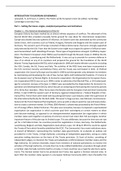Samenvatting
Samenvatting The Politics of the European Union, ISBN: 9781107544901 Introduction To European Governance
- Instelling
- Tilburg University (UVT)
Samenvatting van het boek 'the politics of European Union' zoals voorgeschreven voor het vak Introduction to European Governance (IEG) in het tweede jaar van de opleiding bestuurskunde aan Tilburg University.
[Meer zien]





